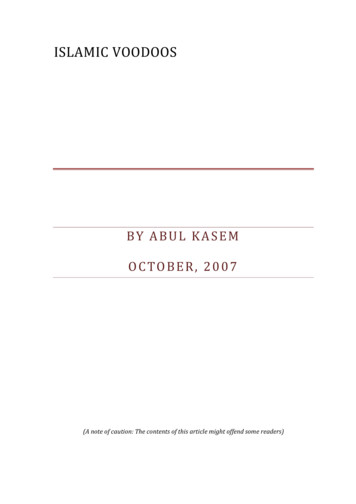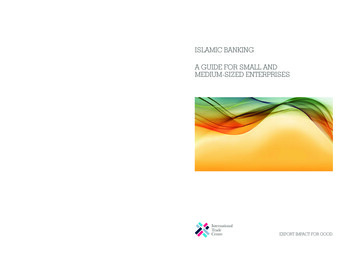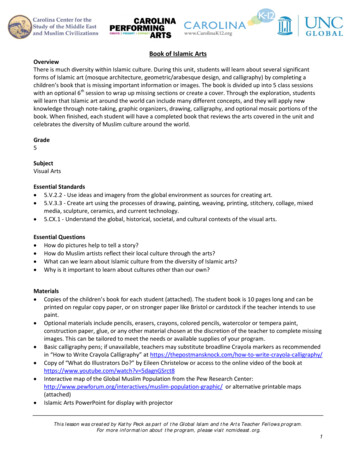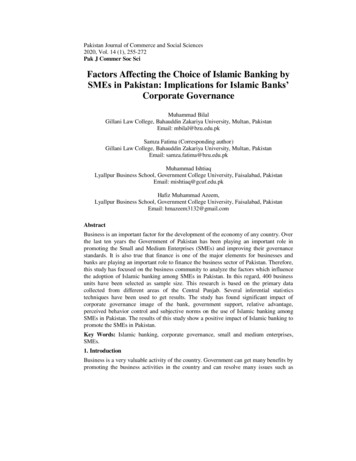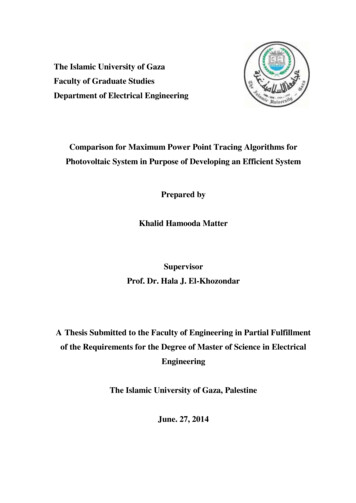
Transcription
The Islamic University of GazaFaculty of Graduate StudiesDepartment of Electrical EngineeringComparison for Maximum Power Point Tracing Algorithms forPhotovoltaic System in Purpose of Developing an Efficient SystemPrepared byKhalid Hamooda MatterSupervisorProf. Dr. Hala J. El-KhozondarA Thesis Submitted to the Faculty of Engineering in Partial Fulfillmentof the Requirements for the Degree of Master of Science in ElectricalEngineeringThe Islamic University of Gaza, PalestineJune. 27, 2014
AbstractRenewable energy is a priority in this day and age, in light of the crisis that has plaguedthe whole world which drives some people to get energy in ways sound and unsound.From this point, the interest in renewable energy and expand from it is the way to people'shappiness and convergence between countries.In this study, we dealt with a range of methods used to get the maximum power and wemake simple compared with each other to determine the merits of each method andlocation for the other way. So it's easy for the researcher to choose the best way forpractical applications in accordance with the limitations and the possibilities available tohimWe have detailed study for all the factors affecting the properties of the cell and theimpact of the change on the resulting energy, factors have been split between internalSuch as the impact of change in resistors and external such as the impact of the change intemperature and radiation and shade.In the end, we have implemented a simple practice demonstrates the use of one of themaximum power point tracking (MPPT) methods to get the maximum power. Thismethod called Incremental Conductance Algorithm. The control is simulated usingMATLAB software.II
ملخص البحث تعتبر الطاقة المتجددة اولوية ىذا العصر في ظل االزمة التي يعاني منيا العالم باسره وىو ما يدفع البببعل لصوصببول اصببي الطاقببة بببالطرو السببصيمة وميببر السببصيمة مببن ىببذا المنطصببو ببان االىتمببام بالطاقة المتجددة والتوسع فييا سبيل لسعادة الناس والتقريب بين الدول . فببي ىببذه الدراسببة تناولنببا مجمواببة مببن الطببرو المسببتادمة لصوصببول اصببي الطاقببة القصببو ب ب ل ماتصبر ومببن تبم قمنببا بالمقارنبة فيمببا بينيبا لتوديببد مميبزات ببل طريقبة وموقعيببا بالنسببة لصطريقببة األاببر بويببث يسببيل اصببي الباوببث ااتيببار الطريقببة االف ببل لصتطبيقببات العمصيببة وفببو الموببددات واالم انيات المتوفرة لديو . تم قمنا بدراسة مفصصة لمعرفة جميع العوامل المؤثرة في اصائص الاصية وتبثثير التييبر فييبا اصبي الطاقة الناتجة وقد انقسمت العوامبل مبا ببين دااصيبة تبثثير التييبر فبي المقاومبات وجابر اارجيبة تثثير التيير في درجة الورارة واال عاع والظل . وفببي النيايببة قمنببا بتطبيببو امصببي بسببيط يو ب اسببتادام اوببد الطببرو لصوصببول اصببي الطاقببة القصو وىي طريقة .Incremental Conductance Algorithm III
DedicationTo my parentsBrothersSistersWife OlaDaughter SehamSon MohammadFriendsIV
AcknowledgmentAt the beginning, I thank ALLAH for enabling me to complete this work . I have takenefforts in this research which really would have been impossible without the indebtedsupport and help of many individuals. I would like to extend my sincere thanks to all ofthem.I would like to starting by expressing my deepest gratitude to my professional assistance,thesis supervisor Prof. Dr Hala J. EL-Khozondar for her guidance support, and constantsupervision.I also would like to extend my thanks to my thesis committee members Dr. Rifa J. ELKhozondar, Dr. Fady E. El-nahal and Prof. Teuvo Suntio.Many thanks go to my parents for their co-operation, prayers and encouragement all mylife helping me going forward especially in completion of this research. Words will not beenough to thank my wife and children for their support.Also, I would like to thank my friend Ahmed Badawi for his continuous encouragement.V
LIST OF FIGURESFigure (1): . .7a) Global primary energy demand, 1990, 2007, and three scenarios for 2030b) Global energy- related demand CO2 emission, 1990, 2007, and three scenarios for 2030Figure (2): P-N junction .10Figure (3): Equivalent circuit models of PV cell. . 11Figure (4): Equivalent circuit models of generalized PV . . 11Figure (5): The I-V curve and power output for a PV module . . . . 12Figure (6): The short-circuit current ISC and the open-circuit voltage VOC . . .13Figure (7): Graphical interpretation of FF . .14Figure (8): Irradiance effect on electrical characteristic. a): I-V, b): P-V . . . 15Figure (9): Temperature effect on electrical characteristic . . 15Figure (01): Block diagram of Typical MPPT system . . . .16Figure (10): Ideal buck converter circuit . . . .17Figure (12): Equivalent circuit of a boost converter . . 18Figure (13): Equivalent circuit of CUK converter . . 18Figure (14): The slope of the P-V array power curve . . . .20Figure (15): Membership function . . .24Figure (16): Example of neural network . . 26Figure (17): Possible states of the three perturbation points . 33Figure (18): Measurement of the power between two MPPT sampling . .36Figure (19): PV system model circuit with a controlled current source, equivalent resistors,and the equation of the model current . 57Figure (20): Equivalent model of PV system in Matlab Simulink with input and output port thatconnect to outside of subsystem . . .58Figure (21): Mathematical model of IS . . .59Figure (22) Mathematical model of IPH . . .59Figure (23): Mathematical model of Im . . . .60Figure (24): Simulink model of the solar PV module . .61Figure (25): I-V characteristic of a cell under varied irradiance . . .62Figure (26): P-V characteristic of a cell under varied irradiance . .62Figure (27): I-V characteristic of a cell under varied temperature . . 63Figure (28): P-V characteristic of a cell under varied temperature 64Figure (29): P-V characteristic of a cell under varied Shunt Resistance .65Figure (30): I-V characteristic of a cell under varied shunt resistance . . 66Figure (31): P-V characteristic of a cell under varied series resistance . . 67VI
Figure (32): I-V characteristic of a cell under varied Shunt Resistance . 67Figure (33): P-V characteristic of a cell under varied Ideality Factor .69Figure (34): I-V characteristic of a cell under varied Ideality Factor . .69Figure (35): P-V characteristic of a cell under varied saturation current . .70Figure( 36): I-V characteristic of a cell under varied saturation current . .70Figure (37): Simulation of two modules in series . .72Figure (38) : . . 74a) I-V characteristic of a cell under different partial shading condition with and withoutbypass diodesb) P-V characteristic of a cell under different partial shading condition with and withoutbypass diodeFigure (39): Circuit diagram of the Incremental Conductance method .80Figure (40): Boost converter . . . .81Figure (41) Operation boost converter . . 81Figure (42) PWM signal . . . .82Figure (43) Operation PWM signal . 82Figure (44): Flowchart of algorithm . . . 84Figure (45): Output voltage . . .84Figure (46): Output current . . 85Figure (47): Output power . . .85VII
LIST OF TABLESTable (1): Type of solar cell . 16Table (2): Defining parameter . 51Table (3): Characteristics of Various MPPT Algorithms . . . .51Table (4): Parameters of PV Array (for more details see appendix A) . . .61Table (5) MPP at different irradiance . . 63Table (6): Summarize the main results different temperature . . .64Table (7): Summarizes the main results at different shunt resistance . . .65Table (8): MPP at different series resistance . . .66Table (9): Summarizes the main results at different ideality factor . . 68Table (10): Summarizes the main results at different Is . 70Table (11): MPP under partial shading with and without bypass diodes . . . .73VIII
ABBREVIATIONSMaximum Power Point TrackingMPPTPhotovoltaicPVGreenhouse GasGHGClean Development MechanismCDMMunicipal Solid WasteMSWSiliconSiDirect CurrentDCFill FactorFFCopper Indium Gallium SelenideCIGSDuty RatioDPerturb and ObserveP&OIncremental ConductanceICParasitic CapacitanceCpFuzzy logic ControllerFLCNegative BigNBNegative SmallNSZeroZEPositive SmallPSPositive BigPBErrorECenter of GravityCOGRipple Correlation ControlRCCReference Maximum PowerRMPOne-Cycle ControlOCCBest Fixed VoltageBFVIX
Linear Reoriented Coordinates MethodLRCMPV Output SenselessPOSSloped Air-GapSAGContinuous Current ModeCCMVariable Step-Size Incremental ResistanceINRModified Perturb and ObserveMP&OEstimate, Perturb and PerturbEPPQuadratic InterpolationQIParticle Swarm OptimizationPSOPulse Width ModulationPWMStimulated AnnealingSAArtificial Neural NetworkANNTotal Harmonic DistortionTHDExtremum Seeking Control MethodESCPolynomial Curve FittingPCFDifferentiation MethodDMPower Conditioning SystemPCSX
Table of ContentsLIST OF FIGURES . VILIST OF TABLES . VIIICHAPTER 1 INTRODUCTION . 11.1 Motivation. 11.2 History of Solar Energy. 11.3 Multiple Benefits of Clean Energy Initiatives1.3.1 Economic Impacts. 2. 21.3.2 Health and Environment Impacts1.4 Clean Development Mechanism1.5 Sources of Renewable Energy1.5.1 Biomass and Biofuels. 3. 3. 4. 41.5.2 Wind Power. 41.5.3 Hydropower. 51.5.4 Geothermal. 51.5.5 Photovoltaic. 61.6 Renewable Energy in the Palestinian Territory1.7 Renewable Energy in the Future. 6. 7CHAPTER 2 PHOTOVOLTAIC CELLS . 92.1 Operating Principle . 92.2 Equivalent Circuit of a Solar Cell . 102.3 Basic Concepts of Solar PV Cell . 122.3.1 The Short-Circuit Current ISC and the Open-Circuit Voltage VOC . 122.3.2 Fill Factor . 132.3.3 Efficiency . 142.3.4 Electric Characteristics of PV Cell . 142.4 Solar PV Technology . 152.5 DC/DC Converter Used for the MPPT System . 162.5.1 Buck Converter . 172.5.2 Boost Converter . 172.5.3 CUK Converter . 18CHAPTER 3 MAXIMUM POWER POINT TRACKING ALGORITHIMS . 193.1 Most Popular Algorithms. 19XI
3.2 Parameters of MPPT Evaluation . 483.2.1 Implementation (Types of Circuitry) . 483.2.2 Sensors (Number of Variables) . 493.2.3 Convergence Speed . 493.2.4 Detect Multiple Local Maxima . 493.2.5 Performance Cost . 502.2.6 Applications (Relationship between cost, time, efficiency) . 503.2.7. Dependency on Array Parameters: . 503.3 Defining Parameter . 513.4 Characteristics of Various MPPT Algorithms . 52CHAPTER 4 MODELING AND SIMULATION OF PHOTOVOLTAIC . 544.1 literature reviews . 544.2 Photovoltaic Models . 564.2.1 PV Module and Array Model . 564.3 Simulation Methods . 574.4 Simulation and Results . 574.4.1 Simulation . 574.4.1.1 PV Array Circuit Model. 574.4.1.2 Saturation Current I S . 584.4.1.3 Light Generated Current . 594.4.1.4 Calculate Model Current . 594.4.2 Results . 604.4.2.1 Parameters of PV Array . 604.4.2.2 Simulink Model of the Solar PV Module . 614.4.2.3 Effects of Solar Radiation Variation . 624.4.2.4 Effect of Varying Cell Temperature . 634.4.2.5 Effect of Varying Shunt Resistance . 644.4.2.6 Effect of Varying Series Resistance Rs . 664.4.2.7 Effect of Varying Ideality Factor (A) . 684.4.2.8 Effect of Varying Saturation Current Is . 694.4.2.9 Effects of Partial Shading on PV . 714.4.2.10 How Minimizing Temperature and Maximizing Irradiance . 78CHAPTER 5 SIMULATION AND IMPLEMENTATION OF INCREMENTALCONDUCTANCE MPPT . 795.1 Modeling of PV System . 79XII
5.2 Boost Converter . 815.3 Pulse Width Modulation Generation(PWM) . 825.4 MPPT Controller . 835.5 Results. 84CHAPTER 6 CONCLUSION AND FUTUER WORK . 866.1 Conclusion. 866.2 Future Work. 87REFERENCES . 88APPENDIX A . 98APPENDIX B . 99APPENDIX C . 100XIII
CHAPTER 1 INTRODUCTIONThis chapter gives us general information about the concept of energy starting with themotivation in Section 1.1. Section 1.2 gives a brief history of energy. Benefits of cleanenergy initiatives are explained in Section 1.3. Section 1.4 is dedicated to cleandevelopment mechanism. Sources of renewable energy are listed in Section 1.5. WhileSection 1.6 presents the renewable energy in the Palestinian Territory. The main futureplans to increase using photovoltaic (PV) cell are summarized in Section 1.7.1.1 Motivation"Renewable energy is derived from natural processes that are replenished constantly. Inits various forms, it derives directly from the sun, or from heat generated deep within theearth. Included in the definition is electricity and heat generated from solar, wind, ocean,hydropower, biomass, geothermal resources, and biofuels and hydrogen derived fromrenewable resources"[1].Pollution resulting from the use of conventional energy leads to environmental healthhazards and economic threats; therefore, the use of alternative energy will reduce theseeffects and reduce the global energy crisis. It also supports global stability and preventconflicts that have erupted for control of conventional energy sources. Recently usingrenewable energy technology increased globally and developed rapidly where it plays animportant role in clean application especially in electric power generation. By using solarenergy, we can get electric energy directly by using photovoltaic module then usingmaximum power point tracker (MPPT) to maximize the photovoltaic output power.1.2 History of Solar EnergyHuman was keen to exploit the natural resources which God harness them for him. Sunis one of the most important resources which have been exploited. Back to the fifthcentury BC, Greeks exploited the sun for heating purposes. The effect of photovoltaiccells discovered by Becquerelin 1839 while experimenting with an electrolytic cell butnot developed as a power source until 1954 by Chapin et al. (Bell Laboratoryscientists)[2]. They invented the first PV cell which capable of converting enough of thesun‘s energy into power to run every day electrical equipment. The practical applications1
of PV system refer to 1973 when the first company established to manufacture terrestrialPV cells in the U.S. It was launched as a fully owned subsidiary of Exxon the firstintroduced to supply power to remote locations (telecommunications, coast guard etc.). Itwas intended in the long run to compete with conventional power sources. However, theboom in the field of solar energy observed significantly in recent years, especially after2000. There are rule to promote challenges facing solar energy such as a RenewableEnergy Law in 2005 which designed to promote the development and utilization ofrenewable energy, and safeguard energy security which amended in 2009 to requireelectricity grid companies to buy all the electricity produced by renewable energygenerators[2].The annual production of cells grew tenfold from about 50MW in 1990 to more than500MW by 2003. This growth continues due to the advantages of solar energy asstandalone and grid-linked opportunities, reliability, ease of use, lack of noise andemissions, and reducing cost per unit energy produced[3].1.3 Multiple Benefits of Clean Energy InitiativesThere are many advantages resulting from the use of clean energy distributed on fields ofenvironmental, economic and health. The clean energy has benefits include diversity,security, improved quality of life, environment and human health. It also improveseconomic gains through avoiding medical costs, higher disposable incomes, and morejobs[4].1.3.1 Economic ImpactsTechnological advances in the field of renewable energy has become clear in recentyears. We note that while the prices of traditional energy sources constantly rise, the costsof Renewable energy decline steadily so the advantages of investment in renewableenergy has become increasingly clear, even in areas that traditionally supports fossilfuels. The main reasons that make renewable energy technologies offer an economicadvantage are labor intensive, so they generally create more jobs invested thanconventional electricity generation technologies, from high-tech manufacturing ofphotovoltaic components to maintenance jobs at wind power. They also use primarilyindigenous resources, so most of the energy dollars can be kept, where the individuals,companies, or communities can reduce their utility bills. For example, schools can cut2
costs by using wind and electric cooperatives can provide cheaper electricity to memberswith photovoltaic[5][6][10].1.3.2 Health and Environment ImpactsAll energy sources have some impact on our environment and health which variesbetween long-term and short-term effects. Fossil fuels are more harmful than renewableenergy sources. Thus, we need to improve access to low-emission, renewable, andmodern energy technologies both at home and at community. They can benefit from longterm sustainability. Notably, the inefficient combustion of fossil fuels and biomass forenergy purposes is the major cause of climate change. Air pollution, often due toinefficient modes of energy production, distribution, and consumption, is a large andgrowing cause of environmental health risks[7], so it is advisable to increase reliance onrenewable energy sources, and support clean energy initiatives. This appears throughbetter air quality which enhances local quality of life. Healthier people reduces strain onthe health system, using fewer sick days also lower carbon dioxide emissions in the nearterm may have a large impact on our ability to meet long term climate goals sincegreenhouse gas (GHGs) accumulate and can remain in the atmosphere for decades,affecting our global climate system and human health for the long term[4][8][9].1.4 Clean Development MechanismThe clean development mechanism (CDM) is one of the flexible mechanisms under theKyoto Protocol. It provides for industrialized countries to invest in emission reducingplants in developing countries also it enables develop countries to meet their emissionreduction commitments in a flexible and cost effective manner and assists developingcountries in meeting their sustainable development objectives.To reach the targets, Kyoto Protocol allowed three flexibility mechanisms: (i) jointimplementation, (ii) clean development mechanism and (iii) international emissionstrading. Among these three mechanisms, CDM plants would achieve their sustainabledevelopment objectives. Such plants would also lead to indirect benefits in thedeveloping country like income generation, employment generation, improvement inlocal air quality, and enhancement of quality of life[11].3
1.5 Sources of Renewable EnergyThe main sources and components used in renewable energy systems included solar,wind, hydropower, biomass, and geothermal resources. In this section a brief is given foreach type of these sources.1.5.1 Biomass and BiofuelsBioenergy term sometimes used to cover biomass and biofuels together[3]. Bioenergyresources are widely available worldwide and have the largest share of all renewableenergy sources. Biomass resource was the first energy source harnessed by humans[13].It comes in many forms. Traditionally, wood, crop residues and animal waste have beenused for heating or cooking, but today biomass is also used in many other ways.Municipal solid waste (MSW) can be used for heat or electricity. Landfill gases can beused for heat, electricity or fuels. Biological conversion of MSW using anaerobicdigestion can produce electricity, heat or fuel gas. Wood and wood wastes can be used toproduce electricity, heat for industrial purposes or domestic space heating.Recently, the interest in producing liquid fuels from grain and dedicated energy crops areincreasing. They are only renewable source of liquid transportation fuels, which can be inthe form of ethanol or biodiesel[1]. Moreover, the carbon in biomass is obtained fromCO2 in the atmosphere via photosynthesis, and not from fossil sources. When biomass isburnt or digested, the emitted CO2 is recycled into the atmosphere without adding toatmospheric CO2 concentration over the lifetime of the biomass growth[3].1.5.2 Wind PowerThe extraction of power from the wind with modern turbines and energy conversionsystems is an established industry. Machines are manufactured with a capacity from tensof watts to several megawatts, and diameters of about 1m to more than 100 m[3].The power output increases rapidly with an increase in available wind velocity. Smallwind speed difference makes a very big difference because the energy contained in thewind increases with the cube of the wind speed. A maximum of about 59 % of the energycan be extracted (Betz number). For this reason, good wind sites are important[16]. Wemust take into account the wind does not blow equally or evenly everywhere on earth.Over open sea or flat stretches of land the wind is stronger than over towns or woods[14].Modern turbines have already greatly reduced noise pollution, which is less than trafficnoise[18], efficiencies and availabilities have improved and wind farm concept has4
become popular in addition to that, wind turbines have become larger, combine withsolar[15].1.5.3 HydropowerThe term hydropower is usually restricted to the generation of shaft power fromfalling water. The power is then used for direct mechanical purposes or, morefrequently, for generating electricity. Other sources of water power are wavesand tides[3]. But Hydroelectric technology is the most mature form of renewableenergy and extremely reliable, but it requires very high initial investments, withlow maintenance cost. Its design life is more than a century. Natural andpumped storage dams are suitable for peak electricity demand. Hydropower ischeap if calculated in the conventional manner[16]. Worldwide, about 45 000large dams have been built for electricity generation, flood protection, waterstorage, agricultural irrigation, navigable waterways and recreation. As a resultof economies of scale, approximately 97 % of hydroelectric plants have acapacity in excess of 10 MW[16]. The main disadvantages of hydro-power areassociated with effects other than the generating equipment, particularly forlarge systems. These include possible adverse environmental impact, effect onfish, silting of dams, corrosion of turbines in certain water conditions, socialimpact of displacement of people from the reservoir site, loss of potentiallyproductive land (often balanced by the benefits of irrigation on other land) andrelatively large capital costs compared with those of fossil power stations[3].1.5.4 GeothermalGeothermal activity in the earth‘s crust derives from the hot core of the earth[12]. Wherethe inner core of the earth reaches a maximum temperature of about 4000 C. Heat passesout through the solid submarine and land surface mostly by conduction and occasionallyby active convective currents of molten magma or heated water[3].Examples of geothermal energy are the natural geysers and hot water sources employedfor power generation and space heating or using deep hot dry rock as heat exchangers bypumping water through the natural rock fissures to produce steam for powergeneration[12].5
1.5.5 PhotovoltaicSolar energy can be used in a number of ways. For electricity generation the mostcommon process is through solar photovoltaic where PV panels convert sunlight directlyinto DC electricity. PV panels, having no moving parts, require little maintenance, arehighly reliable, long lived where the
The Islamic University of Gaza Faculty of Graduate Studies Department of Electrical Engineering Comparison for Maximum Power Point Tracing Algorithms for



